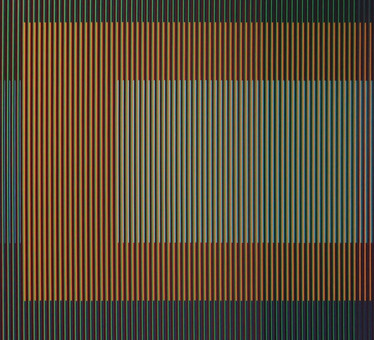Carlos Cruz-Diez

Caracas, Venezuela, 1923 —
Paris, France, 2019
Carlos Cruz-Diez’s work offers the conceptual and sensorial fullness of color by focusing on its circumstantial character, presenting it as an ephemeral event, as a relationship between light and the observer.
Cruz-Diez began his studies around 1940, at the then School of Fine Arts in Caracas. During his training, the artist performed only figurative works, meeting the academic requirements of the time. However, the use of color has instigated him since that initial period. Why was the act of painting limited to the application of pigment on a surface? Were there any other ways to paint? Other ways to color? Such questions motivated Cruz-Diez to have intense contact with art history, anatomy, optics and psychology, developing a research that goes back to the discoveries of Isaac Newton and the impressionists to the incorporation of contemporary technological elements such as the graphic media printing, the use of new industrial materials and the use of video and artificial lighting.
It is especially from the second half of the 1950s that the Venezuelan artist began to materialize his investigations, classifying them according to the type of phenomenon addressed and the discovery made. The Couleur Additive series surprises with the appearance of colors from an optical phenomenon that dispenses with paint: on the canvas, the yellow color appears between a line painted with green paint and a line painted with red paint. There is no yellow paint on the screen, but there is a yellow color on the observer’s retina. Similar interaction occurs in the reflection and color subtraction of the Physichromie series, which began to be developed in 1959.
Such works express the fundamental role of the public for Cruz-Diez. The artist’s works do not give license to contemplative passivity and require the movement of the observer to be realized, something that is even more evident in the environmental works that were conceived since 1965 and assembled only from 1968. Such works, called by the artist of Chromosaturation , consist of rooms formed by translucent plates of red, green and blue acrylic or white spaces carefully lit with those same colors. Within these rooms, the proposal is just to be, to walk, to breathe, to lie down. There, there is no need to discipline yourself for special attention, which will arise spontaneously while the individual is moved to the temporal experience of perception, different from the temporality of ordinary life but running incessantly in its subsoil.
Making themselves and falling apart in front of the participant, the colors presented by Cruz-Diez are in constant movement and are intimately connected to the spatial displacement of the participant himself: animated by the coming of color, the perceptual organs, the feelings move, emotions and reflections, establishing a kinetic exchange that is actually a phenomenological awakening capable of opening the individual to a new world, to the possibility of another real one.
GGS